#enneagram type 6
Explore tagged Tumblr posts
Text
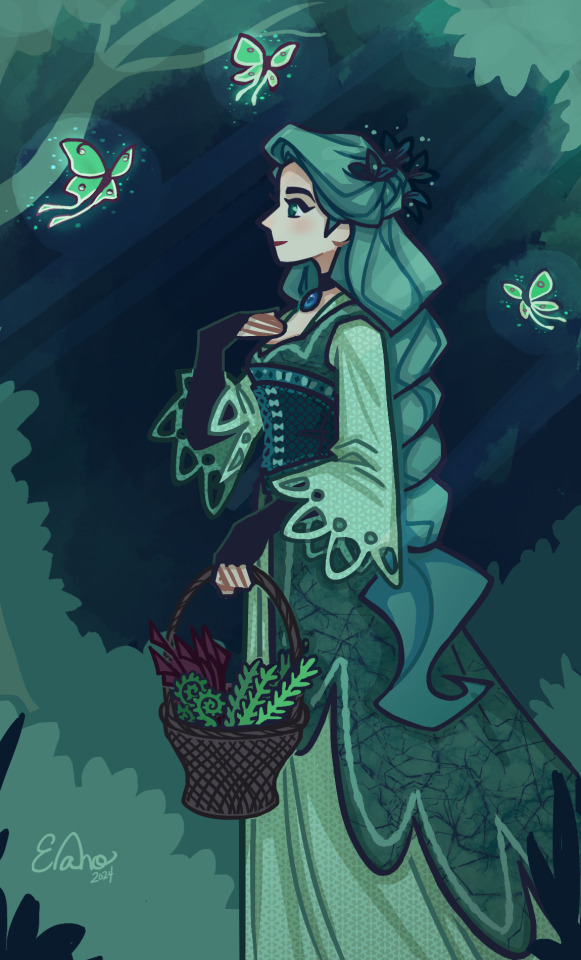
INFP 6w5 with luna moths deep in the Fi Forest. ---------------------------------------------------------------- A character study of my INFP 6w5 with a new dress and braided hair. Admittedly, I'm not very good at drawing backgrounds or creating atmosphere with light/colour, so I wanted to challenge myself more with this painting. It feels like my art 'muscles' are all wobbly and shaky, but I suppose strength is built with repetition and practice :) -------------------------------------------------------------- The darkest parts of the Fi forest receive very little light, making it hard for the unfamiliar to distinguish between night and day. This is because the top layer of the canopy is so thick that light can barely penetrate through the dense brush. Thankfully, having lived in the depths of the Forest for most of their lives, many xxFP 4's, 5's and 6's have expertly honed their Ne or Se to survive the precarious conditions. Monsters and demons thrive in dark places, making well-developed Sensing or Intuition necessary for inhabitants to protect themselves while avoiding unwanted and potentially lethal encounters. Strangely, their willingness to embrace darkness allows light to be found, even in the most unlikely places...
#mbti personalities#mbti#mbti types#mbti infp#typology#mbti fanart#mbti story#infp 6w5#enneagram 6w5#enneagram type 6#enneagram types#mbti and enneagram#fi forest#mbti introverted feeling#character design#illustration#portfolio 2024
79 notes
·
View notes
Text









enneagram type six | the loyalist, the skeptic, the truth-seeker
Sixes are reliable, hard-working, responsible, and trustworthy. Excellent “troubleshooters,” they foresee problems and foster cooperation, but can also become defensive, evasive, and anxious. They can be cautious and indecisive, but also reactive, defiant and rebellious.
fear won’t go away, but i can keep it at bay these invisible walls just might keep us safe
#enneagram type 6#6w5#6w5 the defender#enneagram type six#enneagram#sleeping at last#enneagram moodboard#moodboard#enneagram 6
2 notes
·
View notes
Text
Enneagram 6 Characters




From Avatar: the Last Airbender:
Sokka: SO 6w7, 368, ENTP
From Fruits Basket:
Kyo Sohma: SX 6w5, 368, ESFJ
Mitsuru: SO 6w7, 261, ISFJ
Kyo's Biological Father: SX 6w5, 368, ESFJ
#enneagram#enneagram type 6#enneagram 6#the loyalist#the skeptic#the loyal skeptic#the defender#the buddy#fruits basket#furuba#fruba#atla#avatar: the last airbender#avatar the last airbender#sokka#kyo sohma#kyo sohma's biological father#mitsuru
3 notes
·
View notes
Text
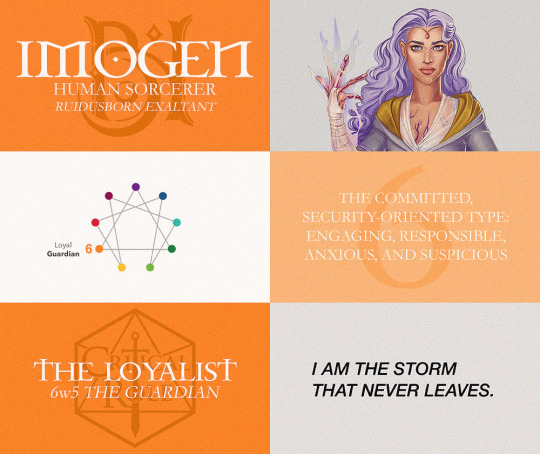
CRITICAL ROLE: BELL'S HELLS (2021–) ENNEAGRAM TYPES ★
Imogen – Type 6(w5): The Guardian
Sixes are hard-working, responsible, and trustworthy. They foresee problems and foster cooperation, but can also become anxious, defensive, and evasive. They can be cautious and indecisive, but also defiant, reactive, and rebellious. They typically have problems with self-doubt and suspicion. Sixes are the most loyal to their family and friends. They will hang on to relationships of all kinds far longer than most other types. Sixes are also loyal to beliefs, ideas, and systems – even to the belief that all authorities should be questioned or defied. Enneagram 6w5s are very loyal people who value clarity and honesty. They love to be surrounded by good people, and they appreciate having supportive and trusting relationships that can be their safe space.
Sources: 1 2
#imogen temult#imogen#human#sorcerer#ruidusborn#bell's hells#critical role#dungeons and dragons#dnd#d&d#enneagram#enneagram type#enneagram type 6#enneagram type six#enneagram 6#enneagram six#type 6#type six#6#six#art#digital art#photoshop#graphic design#graphic#artists on tumblr#artist on tumblr#annemarieyeretzian
27 notes
·
View notes
Text
this was so enlightening, especially the additional triads which i hadn’t heard of before! the harmonic triad especially made so much sense.
Enneagram system
A rewrite/more in depth post of the Enneagram system compared to my last post on it. Not an expert. May change later.
If you like kpop and typology, check out my blog. I do type analysis on idols and typology notes.
___
What is Enneagram?
I mainly took notes from Riso Hudson theory.
A typology system that categorizes personalities into 9 different types. Each type is numbered from 1 - 9.
Each type has a desire and fear that motivates their actions in life.
Core and Wings
Core: Our main type. It is the foundation of our personality and does not change.
Wing: Acts as a complement to our core. Wing can be one of the two types that sit beside core type. E.g a core 2 can have a 1 wing (2w1) or 3 wing (2w3). But is not necessary to use since wings can change and/or can be balanced.
Levels of Development
Summary of healthy - unhealthy levels of personality
- Healthy levels -
Level 1: Liberation
Let go of self image so we are free to express ourselves however we want. Self acceptance of all traits.
Level 2: Pyschological Capacity
Begin to identify with positive qualities in our personalities and learn to improve ourselves with them.
Level 3: Social Value
Still strongly identify with our set self image and make effort to maintain image. Want to share our good talents and abilities to make a positive effect on self and others.
- Average levels -
Level 4: Imbalance/Social roles
Idealization of self image; have a major focus on either good or bad qualities, no in between. Fear is an obstacle here.
Level 5: Interpersonal Control
Insist on self image being accepted by others, which can cause conflict. Can lead to controlling and manipulation.
Level 6: Overcompensation
Overcompensate due to underlying negative feelings. Desperate for others' acceptance.
- Unhealthy levels -
Level 7: Violation
Desperation for acceptance leads to violation of one's self and others. Serious conflict can occur. May victimize themselves to excuse offensive actions.
Level 8: Obsession and Compulsion
May be overly obsessed with an image of who they want to be. Deceives others
Level 9: Pathological Destructiveness
Most unhealthy state, display very toxic traits and behaviours, may have mental breakdown
Disintegration vs Integration
Or basically Stress vs Growth
Disintegration: When under heavy amounts of stress, a type will go into their disintegration type. They will pick up the negative traits of that type and act like the unhealthy version of it.
Integration: When maturing/developing positively, a type will go their integration type. They will pick up the positive traits of that type and improve their character.
___
* I will only give short descriptions for the triads. I will explain more in depth in individual posts.*
Centers of Intelligence
There are 3 centers of intelligence. Each center shows how and why we solve issues in life.
Gut/Instinct/Anger (types 1, 8, 9)
Gut center focuses on reacting and taking action immediately. This triad has an issue with control and anger.
1: Often perfectionists who repress their anger in order to remain morally good. They see their anger in a negative light.
8: The most open and comfortable with their anger. Uses it to assert boundaries, especially since this type fears vulnerability.
9: Often a passive type that dismisses or downplays their anger. They fear conflict and may worry being more assertive will cause a negative effect on themselves and others.
Heart/Image/Shame (types 2, 3, 4)
Heart center focuses on self identity and connections. This triad wants love and recognition and do what they believe is best to get that. They struggle with self worth.
2: They want to be needed and helpful to others. Pride themselves on being of service. Wants to receive love and to give love.
3: The most image oriented type. They always try to show their best selves and best efforts in order to seem admirable. Fears being worthless.
4: Wants to create a unique image for themselves, believes being boring will make them unloveable.
Head/Thinking/Fear (types 5, 6, 7)
Head center focuses on ideas, making rational decisions, and gathering info. This triad deals with fear and uncertainty.
5: The most internalized head type. 5's want to gather as much knowledge and resources as possible in order to stay secure and independent.
6: Quite an anxious type who seeks security through relations with others.
7: This type fears pain and suffering and seek out experiences in order to avoid negativity.
___
Other triads
- Harmonic Triads -
How types handle conflict, coping mechanism
Reactive (4, 6, 8)
Reactive types are not afraid to show and speak about their true feelings. They may seem "dramatic" in a way.
4: Melodramatic and self absorbed in negative feelings, drowns in intensity
6: Will argue, stick up for the right thing, moody, anxious
8: Big and loud reactions, can be very fiery
Positive (2, 7, 9)
Positive types dislike negativity and conflict and have their own ways of avoiding such tension. Optimistic during hard times.
2: Actively tries to be a good and kind person, only tries to focus on the good aspects of people
7: Seeks out fun opportunities to make their life exciting (basically distraction)
9: Values harmony and peace, will not risk any type of action that will disturb these values
Competency (1, 3, 5)
Competent types are often perfectionists who want to show their best selves. Objective and rational.
1: Strives to be correct and right, wants to be precise in what they do
3: Represses softer emotions to keep up a certain image, thrives with work/passions so they can be the best at what they do
5: Detached from feelings to remain logical and objective, knowledge seeking
- Hornevian Triads -
Relationships with others, how they get what they want
Assertive (3, 7, 8)
Assertive types go against people to get what they want. Do not back down easily, can seem aggressive and forceful.
3: Pushes through obstacles for achievements, goal oriented
7: Asserts their right to have fun, refuse to be restricted
8: Asserts power and strength, places boundaries
Withdrawn (4, 5, 9)
Withdrawn types are very internalized and do not show their needs openly. Deals with things alone.
4: Feels something is wrong with them internally, feels misunderstood
5: Detached from others as to not drain their own energy, will figure it out themselves
9: Introspective, lets life happen
Compliant (1, 2, 6)
Compliant work with people to get what they want. Builds relationships for security, wants to be helpful to others.
1: Doing the right thing instead of one's own wants
2: Focus on other's needs more instead of self
6: Tries to build a safe and secure environment by getting ppl to work together
- Object Relations -
How we are affected by others, our own affect on others, how we react to personal wounds
Attachment (3, 6, 9)
Seek out bonds and companionships for particular reasons. Individuality vs adaptation.
3: Changes their image to suit whoever they are with in order to meet expectations
6: Creates support systems to help with their self doubt and indecisiveness
9: Adapts to the energy of the environment to keep harmony
Frustration (1, 4, 7)
Triad gets frustrated when their needs aren't met.
1: Has a need to improve every little imperfection they find
4: Dislikes shallowness, longs for depth and complexity
7: Not enjoying experiences, not feeling fulfilled
Rejection (2, 5, 8)
Their own needs feel unimportant to others, so they reject their own needs as well.
2: Rejects the need to receive love and guidance, instead focuses on connecting with others and helping them.
5: Ignores and minimizes all their needs, offers knowledge and expertise in some hope of being acknowledged for their intelligence.
8: Rejects by being never putting their guard down, wanting to appear strong and as the protector of others.
___
Subtypes
Claudio Naranjo theory
There are three subtypes/instinctual variants that show our drive in life. There are 27 different subtypes in total.
Self Preservation (Sp)
Focuses on physical safety and security. Our physical health, financial security, obligations, and comforts.
Sexual/One - on - one (Sx)
Wants intensity and deep connections, one on one relationships are preferred.
Social (So)
Prefers to be in a community, wants to create good connections and bonds with others. Socially aware, focus on group goals and contributions.
___
Tritype
Katherine Fauvre theory
A minor but still interesting piece of Enneagram. Tritype is formed of your 3 dominant types from each center. The first number will always be your core, followed by your other 2 dominant types.
E.g 369. 3 = core, heart. 6 = head. 9 = gut.
___
Enneagram notes
___
Side blog:
Kpop astrology @rainy-astrology
Kpop fanarts @rainy-artworks
205 notes
·
View notes
Text
I want to believe No, I choose to believe That I was made to become A sanctuary
Fear won’t go away But I can keep it at bay These invisible walls Just might keep us safe
— Sleeping At Last, “Six”
1 note
·
View note
Photo


(via Enneagram Comparisons - Type Six and Type Nine)
#enneagram#enneagram type six#enneagram type 6#enneagram 6#enneagram type nine#enneagram type 9#enneagram 9#9w8#9w1#6w5#6w7#enneatypes#personality types#personality traits#personality tests#personality typology#mbti personality types#mbti
1 note
·
View note
Text
questions to type yourself (enneagram edition)
how do you set boundaries with the world around you? (do you assert yourself, do you blend in, do you please others, etc etc)
how do you act during stress? (are you more positive, do you stay calm and try to be "objective," do you get emotional, etc etc)
how do you act in anger? do you experience it often?
how do you act in shame? do you experience it often?
how do you act in fear? do you experience it often?
how do you act in relation to others in conflict? (withdraw, go-with-the-flow, upfront, etc)
how do you "get what you want?" (more demanding + straightforward, believe it should be earned, focus on self, etc etc)
what is your coping mechanism? (do you distract yourself, do you try to act more neutral, stay in denial, try to rationalize, etc)
#enneagram#enneagram 9#enneagram 7#enneagram 4#enneagram memes#type 4#type 9#type 5#type 6#type 7#type 8#type 1#9w8#4w5#4w3#5w4#5w6#6w5#6w7#7w6#8w7#8w9#2w3#3w2#type 3#enneagram 8#enneagram 3#enneagram 9w1#9w1#enneagram types
200 notes
·
View notes
Text
Enneagram 6 Subtypes Explained



Social 6 "Duty"
The Social 6 is characterized by their desire to belong to a specific group of people. They look for these social and emotional systems in which they can find comfort and emotional safety. Usually perceive as a rule follower by many in the community. However I find this to partial true. The SO6 does look for a system of support however, they can also look for a support system that rebels or is against the status quo. The groups they look need to share similarities to them or desirable traits. This 6s can be very outgoing and sociable BUT make no mistake they are still a 6. Meaning that they still share a general skepticism/cynicism of others. They can look like 1s (very responsible) and imo 7s (due to their outgoing and social nature especially if they have a w7)
Characters: Susan Pevensie, Marie Moore, Percy Jackson, Leon S. Kennedy, Xiao Yu, Scott Summers, Kagame Higurashi and Kendall Roy.
Self Preservation 6 "Warmth"
The anxiety the Sp6 harbors can be linked to their high awareness of their current environment as well as the ongoings of it. This subtype usually gravitates more to system that maintain their emotional comfort via order. Usually practical and hardworking this 6s maintains itself safe by maintaining a strict order around themselves. For this 6s the safety in their environment is both physical and metaphysical. Imo they are the most skeptical of all 6s approaching most things with cynicism. Being very careful as to who they let in their space. This subtype can look like a SP5 (due their more reserved nature however the SP6 does look for connection) and SP9s due to their environment focus.
Characters: Edward Cullen, Miles Morales, Bonnie Bennett, Chihiro, Asami Sato, Armin Arlert , Dipper Pines and Pearl
Sexual 6 "Strength"
Often confused by 8s this subtypes fight the fear the inner 6s have by standing on their own. However, unlike the 8 (who look for power and autonomy by themselves) the SX6 looks to fight their fear (by trying to connect with others). This subtype has an edge to them unlike the other 6s. Their desire for connection is more on the aggressive side. They are the most open about their skepticism of others. The focus for this subtype is stability in interpersonal relationships. As mentioned previously this subtype can look like an E8 (simply due to their reactivity) and some 4s (due to their edginess and over expression of emotion).
Characters: Claudia, Joel Miller, Laura Palmer, Sasuke Uchiha, Maggie Rhee, Killua, Chloe Price and Jared Grace
#personality types#mbti personality types#16 personalities#enneagram#mbti#ennegram#zodiac#typology#zodic signs#personality typology#enneagram 6#6w7#6w5#type 6#edward cullen#twilight#life is strange#chloe price#su pearl#gravity falls#dipper pines#twin peaks#laura palmer#studio ghibli#spirited away#Chihiro#attack on titan#armin arlert#leon s kennedy#resident evil
63 notes
·
View notes
Text
The Enneagram Explained ⚔️ Defence Mechanisms & Self-Sabotaging Behaviors 💣🔪
By Larissa
(This is an excerpt from a workshop I taught in 2023) If you want the accompanying "Unf*ck Yourself" mini workshop + pdf workbook join the membership and get it instantly. I apologize for how dry and cringe the names/descriptions are.
To watch/listen instead:
youtube
One of the main ways you can stop operating out of autopilot, quit the shit patterns and actually get what you want is by:
Being with the discomfort of not operating out of your personality trap + shadow (being conscious, making different choices, regulating your nervous system in the moment with breath, tapping, affirmations).
Integrating the opposite of your personality's "belief" (the shadow).
This sounds simple but it actually requires a considerable amount of bravery and determination. Which is why most people who learn the Enneagram don’t actually use it for self-growth. Because it’s more fun to chit chat about and study than to actually apply to our own lives.
The personality’s belief structure creates behaviors and defense mechanisms. These beliefs and behaviors create the shadow.
The defense mechanisms come from Freud's psychoanalytic theories and have been correlated to Enneagram theory by multiple sources and evolved over time with other people's ideas (Fritz Perls, Oscar Ichazo, Helen Palmer, Naranjo, etc). I won’t be getting into any of that, I’m just going to apply them in how I see them as useful. I’ve also added behaviors that I notice in each of the types.
I’m not sharing these to shame anyone or be judgmental, because we’re ALL doing at least one, if not three or more of these patterns. I’m using the Enneagram as a framework to show you how to spot patterns, unuseful beliefs and shadow at a much quicker pace than if you’re just doing it from just generic journaling prompts or waiting for something to “happen” before you address it. This way you have a pathway to start looking at the problems before your life goes to total shit.
Each type’s flawed belief (“If I am not ___ I don’t exist /I am not me/I am not safe”) manifests itself through behaviors and actions.
This process is unconscious. Even if you were aware that you were doing some of this stuff, it’s not your fault. It’s what we were programmed to do. But by integrating our shadow and coming into acceptance and wholeness we get to make better choices, think supportive thoughts, feel better, more useful and aligned feelings. And you can also catch yourself in the act and check yourself before you wreck yourself.

ENNEAGRAM TYPE 1 - “DADDY”
1’s prefer to see themselves as being conscientious and above the degenerate riff raff. They’re proper, correct and in integrity, therefore they cannot see themselves as lazy, foolish, wrong, messy or "bad.” Of course, when going too hard into the personality type’s false belief, it creates a big ol’ shadow.
1’s avoid outwardly expressing anger to remain “objective” and in control. Because expressing “anger” is “bad.” To be imperfect, incompetent, wrong or out-of-control is death to the 1. This mechanism reinforces the 1's ego because it assures them that they are right, proper, perfect, and correct. Therefore, their survival and identity continues. However, because the 1 is an anger/gut type, they’re constantly churning irritation factories.
If the 1 catches themselves in the act, or someone else does (gasp), it may increase the dissonance between the Shadow and Unintegrated Self if they don’t understand that it’s just their personality bs. Because the 1 utilizes “anger” they are unlikely to allow themselves to see themselves as incorrect, in the wrong, imperfect.
How this manifests:
Reaction Formation: 1’s can express the opposite of their actual feelings and desires. They do this to reinforce their ego as “not being angry” (being perfect, right, correct, proper, good). Expressing anger is “bad” or what people who have no self-control do.
Channeling unexpressed anger into physical activities - going hog wild on cleaning, obsessively exercising, restricting food/hedonistic delights, perfectionism fixations, taking a red pen to their life.
Criticality + judgmental concerns projected onto people around them, for their “own good.” To the 1 they’re being responsible, doing the right thing.
Splitting: Seeing things in black and white under stress (this is good, this is evil). In super low health this can lead to extreme behaviors, like witch-hunting, finger-pointing, being the ‘voice of God’ / judge, jury and executioner.
Rationalization: 1's can rationalize to justify their self-righteousness. “This is the most correct, right, or efficient way to do the thing, therefore I am right and you are wrong.” If you don’t do what I say, it will be to your own detriment.
Hypocrisy: Projecting their own denied desires, feelings and even private behaviors by condemning the same desires, feelings and behaviors in others. They know the right way to be, and you are not being it. They can become preachy about whatever they take issue with, in order to unconsciously overcompensate for their secret bad behavior or naughty thoughts. This ties directly to Shadow Work, because 1's and 1-fixers can have a pungent Shadow full of all kinds of misdeeds and “dark” desires, but be totally blind to them while criticizing others for the same things.
Example: The anti-gay politician who is having an affair with a man, or the barbiturate-poppin' mom who wages a neighborhood campaign against drugs.
OCD: Obsessively creating more order and rightness in their physical environment, relationships, or self. They can go into “perfecting” mode in order to feel in control of something they cannot control, where they exert order onto their surroundings and right wrongs (like becoming obsessed with cleanliness in their home or laying out ‘rules’ that others must follow).
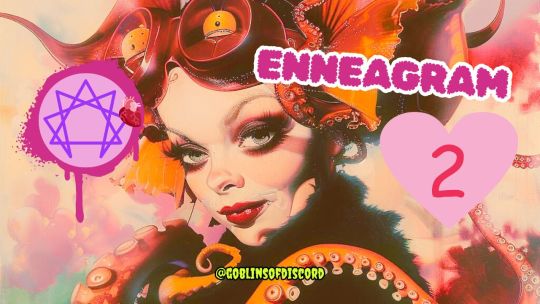
ENNEAGRAM TYPE 2 - “MOMMY”
2’s prefer to see themselves as being loving, nurturing, selfless, self-sacrificing, caring towards others, concerned and kind-hearted. Therefore they cannot see themselves as selfish, self-centered, giving to get, cold, heartless or "bad”. Of course, when going too hard into the personality type’s false belief, it creates a big ol’ shadow.
2’s avoid feeling selfish or needy, by refusing to directly ask to get their needs met or receive what they truly wish from others. 2's unconsciously repress these needs and desires to reinforce their type's ego because it assures them that they are self-sacrificing, needed, good and loving. Therefore their survival continues.
If the 2 catches themselves in the act, or someone else does (gasp), it may increase the dissonance between the Shadow and Unintegrated Self if they don’t understand that it’s just their personality bs. Because the 2 utilizes “pride” they are unlikely to allow themselves to wallow or even acknowledge any wrongdoing or selfishness on their part. It’s the other person’s fault, the 2 is blameless.
How this manifests:
Repression: 2’s hide their needs and "selfish" desires from themselves in order to maintain their caring and indispensable self-image. They use Repression to AVOID feeling needy, unnecessary or rejected. Because of their type structure, they can't see how they are in need of anyone else's help or how they are anything other than self-sacrificing. They cover up these feelings with flattery, offers of help, being intrusive and overly nice.
2’s prioritize others’ needs in the hopes someone will prioritize theirs. But then when that happens, the 2 goes into rejection mode and wants to get back into position as ‘the helper’ as that’s where their identity is invested.
The 2 projects their needs onto those around them by being overly helpful or intrusive. If they feel like they're not being appreciated or getting their needs met, they can move into covertly "punishing" behaviors to the person they keep giving to or subconsciously create situations in which the person might be forced to give back to them.
Example: The 2 wants help cleaning from their spouse, so over-cleans to the point where they become ill so that their partner is forced to pick up the slack or show them care for all of their self-sacrificing. This can also manifest in ways like them offering to do something and then making the other person wait to receive if they are feeling secretly resentful or not shown adequate appreciation or having their self-image adequately validated.
In low health, 2’s can use “Identification” to take on the needs and worries of those around them as if it’s theirs. They become fretful over other people’s problems. Anything that hurts their loved one hurts them. And it becomes covertly narcissistic, wherein they can make someone else’s suffering about themselves, but also their wins. “If it wasn’t for my help, they wouldn’t have accomplished that.” They can secretly (or not secretly) want undue credit for “help” they’ve provided (whether solicited or not).
2’s use “Reframing” in collaboration with “Repression.” They can reframe their intentions (to maintain a pride in their pure and loving intentions) and reframe others intentions too, lest it burst the sugar-coated bubble they’re desiring to live in or reflect back to them that they’re unwanted.
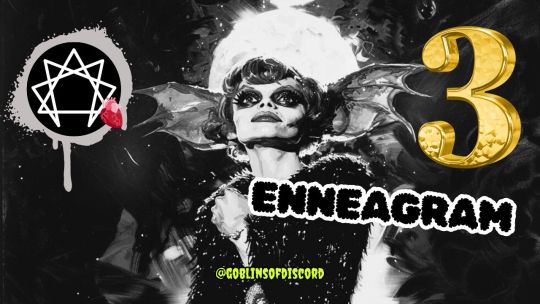
ENNEAGRAM TYPE 3 - “SHAPESHIFTER”
3’s like to see themselves as impressive, competent, successful and admired or valued for what they do or are. Therefore they cannot see themselves as losers, failures, or less than others. Of course, when going too hard into the personality type’s false belief, it creates a big ol’ shadow.
3’s avoid feeling like a failure or worthless by adapting to external ideals, competing, and striving. 3's unconsciously use “Identification” to reinforce their type's ego because it assures them that they are valuable, worthy, admired and successful. Therefore their survival continues.
If the 3 catches themselves in the act, or someone else does (gasp), it may increase the dissonance between the Shadow and Unintegrated Self if they don’t understand that it’s just their personality bs. Because the 3 utilizes “deceit” they are unlikely to allow themselves to own their failings or true feelings if it interferes with the image they’re projecting.
How this manifests:
3's use "Identification" as a defense mechanism, by unconsciously assimilating with the "other." They use this to avoid feeling like a failure. How this shows up is that they take on the traits, characteristics, attributes, aesthetics, preferences, values and mannerisms of important people in their life, groups, people they see as valuable and those they admire or envy. They do this to create an image of success (to themselves and/or others).
Denial/Projection: 3’s can blame others for their failures or what isn’t working for them, offloading image fails onto others to distance themselves from shame. Just like they can take on others traits/behaviors/stories, they can offload those same things onto others as well.
Deception: This collection of traits is their "self image" and where their ego and self-worth resides, and because their external sources and what is valued may change, it can give 3's a shapeshifter quality depending on who or what they're surrounded by, what they value, what they do. Underneath this layer of shiny baubles is still a 'shame type' and so without this sometimes fragile self-image being upheld they are but a raw, shameful nerve. Because of this, they can lose contact with their own internal compass, needs, desires and their authentic self. They prioritize what gets them those positive hits and bolsters their ego/self-image. They can be totally asleep to this inner incongruence, and be deceiving themselves, especially in lower levels of health.
Numbing/Workaholism: 3’s can use numbing so they don’t get stuck in the emotional swamp and become unproductive. They can power down the “I’m a failure, I’m upset, I’m emotional” aspect and power up the drive to override emotional slop that might get in their way. They might override this with going hard into working around the clock, substances, shopping/spending a lot or doing something flashy to bolster their self-image.
Competition: 3’s can get caught up in competition, using others as a stepping stone or a way to boost their own image by comparison (“see how much better of a job I’m doing than Ted.”) They might do this to the point where they end up chasing someone else’s dreams and totally shooting themselves in the foot.
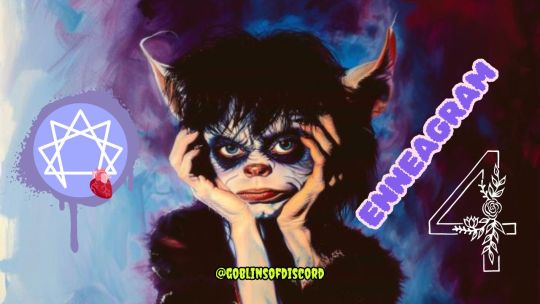
ENNEAGRAM TYPE 4 - “DISDAINFUL DEPRESSIVE”
4’s like to see themselves as separate, uniquely flawed, deep, and the special exception. Therefore they cannot see themselves as mundane, relatable, ordinary, adaptable, or even for many 4’s functional. Of course, when going too hard into the personality type’s false belief, it creates a big ol’ shadow.
4’s avoid feeling mundane, ordinary, relatable, shallow, functional or happy. 4's unconsciously self-sabotage and focus on the negative and what’s frustrating, to reinforce their type's ego because it assures them that they are deep, different, uniquely flawed and unlike anyone else. Therefore their survival continues.
If the 4 catches themselves in the act, or someone else does (gasp), it may increase the dissonance between the Shadow and Unintegrated Self if they don’t understand that it’s just their personality bs. Because the 4 utilizes envy (what is missing) they are unlikely to allow themselves to see where they are functional, relatable, understandable or even happy. They subconsciously craft a self-image that rejects any "positive" information about themselves that comes into conflict with this existing "negative" image.
How this manifests:
Introjection: Introjection is presented as absorbing another person's identity or feelings (like a parent) and transferring it to themselves. However, it's more nuanced and specific than that for 4’s. 4's aren't just taking in any old information, they're unconsciously taking in evidence that they are broken, estranged, alien, fucked up and damaged - and this is great news to them. While the external world may be giving the 4 fuel, their experience has almost nothing to do with the outside world. The outside world is just serving to fuel the 4's internal narrative. The 4 weaves these evidentiary mementos into a story. They identify with specific negative traits that reinforce that they are separate, rare, deeply flawed so as to never quite be understood or capable of being happy and functional.
They do this unconsciously as a way to cope with the pain of feeling broken, unwanted, dysfunctional and different. They weave the negative narratives into their identity and shape it into a way that makes them feel in control of it, to project depth and meaning onto it vs someone or something outside of themselves creating their story and making it shallow. The more they associate into this negative state, the more dysfunctional they can become and the more it supports their type's ego structure. Without these narratives they feel naked and non-existant. Because their self-image is inherently negative, they are “positively” associated with being in a negative, frustrated, unsatisfied state.
Idealization: Idealizing people or situations as a way to generate feelings to pull the 4 away from the mundane reality/experience. This idealization is a frustration pattern designed to keep them in a loop of disappointment and longing because nothing will ever live up to what they hope, something will always be missing and the 4 can never truly actualize or be happy as a result. And if it is everything they’ve ever wanted, the 4 is likely to find something wrong anyway or create a problem where there is none.
As a result, the 4 might self-sabotage opportunities that would actually aid them in being functional, capable, happy, or get them what they claim they want. They may discard things, people, ideas, pursuits if they feel too easy, cheap, relatable, mundane. Or keep churning up issues and provocations that will lead to them being able to say, “see, I never get to have what I want.” Or “I knew no one would understand.”
Splitting: 4’s reject what’s “not me” and often find what’s not to their tastes or “not me” disgusting. Everything that’s not in the frustrated realm that the 4 approves of is superficial, shallow, ugly, vapid, horrible, etc. For the faceless masses, not the 4. Being at odds with reality helps reinforce their self-identity. I’m not like that, therefore I’m deep.
Because 4’s are usually creative or self-identify with the idea of being an artist/writer/creative, their tragically romantic, broken and disdainful views can be expressed through their art. They may overdo it in making it unpalatable or abstract. Or if they become popular they may self-sabotage their own success or self-image by being provocative, turning on their fans/the public, becoming moody, self-destructive or unpredictable. They’ll likely move away from what is expected or desired by their fanbase, even if they secretly desire an audience. Or maybe they’ll over-specify how they present themselves and shroud themselves in mystery in a way that others cannot easily relate to, they can only *bear witness.*
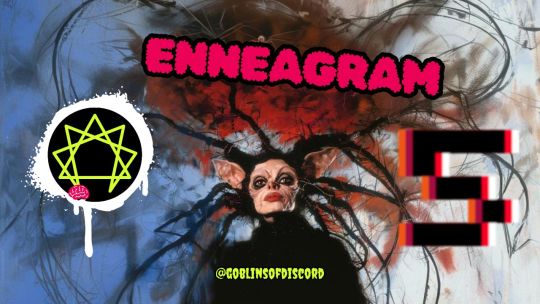
ENNEAGRAM TYPE 5 - “BRUNDLEFLY”
5’s like to see themselves as insightful, competent, self-sufficient, independent and objective. Therefore they cannot see themselves as emotional, human, helpless or dependent on others. Of course, when going too hard into the personality type’s false belief, it creates a big ol’ shadow.
5’s avoid feeling dependent on others, helpless, depleted, or engulfed in the messy world. 5's unconsciously retreat inwards and withhold energy and information, detach, and compartmentalize to reinforce their type's ego because it assures them that they are competent, objective, smarter than everyone else and above the mortal coil.
Because the 5 utilizes avarice (hoarding inner resources) they are unlikely to allow themselves to allow themselves to be put in a position where they are “needed” for anything outside of the scope of their specific interest/competency focus, or entangle themselves with hot messes (people or situations). Of all the types, this is maybe the one that is least likely to give a shit if they have a shadow, tbh.
How this manifests:
Isolation: 5’s retreat and protect their inner sanctum from being invaded or picked clean by the outside world. They use isolation to avoid dependence on others or having to be interlaced with their chaotic whims and needs which may disrupt what the 5 would rather be doing with their time (some kind of mind pursuit). They may design their entire lives to protect themselves against intrusion.
Detachment: 5’s use detachment as a means to cope when they feel overwhelmed. They disconnect from and retreat from their own and others’ unstable feelings. In order to feel competent and safe and conserve their mental resources, they can cut all contact or need for the outside world.
They use ‘rejection’ methods of cutting off and compartmentalizing to ensure they’re not swallowed up in the messy ass human bullshit of this humdrum existence. This may show up as minimizing their needs (physical, relational, financial, emotional). They’re the most likely to live in some secret, off-grid tiny home. Not the one with all the gardens and crops and goats, but the one that has the bare minimum to survive where they can focus on their studies or whatever their mental obsession is, far away from other people.
They can have totally hidden worlds within worlds that others know nothing about. Each world dangerously close to being lopped off at a moment’s notice if the 5 sees no use for it anymore. They dump all of their energy into their main pursuit because it’s where they feel “safe” and valuable, and so the outside world interfering with that feels like an attack on their very existence. By overdoing this one area of “competency” they can actually make themselves unable to actually be independent or functional. So to them they may seem overly competent, but to the outside world they may seem bizarre and dysfunctional.
5’s use compartmentalization of emotions, energy, and relationships. Separating their thoughts from feelings, and putting people into boxes to be dealt with or utilized instead of truly connected to. This can have a dehumanizing effect on the people around them who don’t want to only interact with the 5 when they have the inner resources or only interact with them on narrow and specific terms. By doing this, the 5 effectively shuts out having to deal with whatever they don’t want to but also hacks off pieces of their own heart, spirit, and humanity which is the only true place to create and mine for the insights and independence they seek.
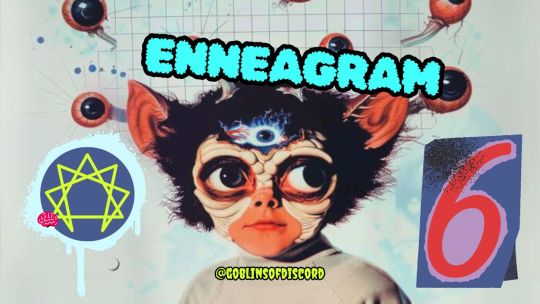
ENNEAGRAM TYPE 6 - “CITIZEN EMO”
6’s like to see themselves as loyal, hardworking, just a regular person, authentic, responsible, fair and connected to the family/community/tribe, etc. Therefore they cannot see themselves as bad, traitorous, pompous or “too good.” Of course, when going too hard into the personality type’s false belief, it creates a big ol’ shadow.
6’s avoid feeling unsafe, uncertain or abandoned in their attachments and support systems (physical, group, partner). 6's unconsciously seek security/safety (and dangers), truth (and lies) and support systems they can trust and rely on to reinforce their type's ego because it assures them that they are accepted, part of the tribe, safe, secure, supported and prepared. Therefore their survival continues.
If the 6 catches themselves in the act, or someone else does (gasp), it may increase the dissonance between the Shadow and Unintegrated Self if they don’t understand that it’s just their personality bs. Because the 6 utilizes “fear” (and anxiety) they are unlikely to allow themselves to relax, ease up, stop hunting for discrepancies or what could go wrong.
How this manifests:
Projection: 6’s project their worst fears and worst case intentions onto other people. They’re always sniffing out danger in the world and in their connections. Who’s being disloyal? Who’s up to no good? They can engage in investigative, gossipy behaviors, seeking out clues of their worst fears. Sometimes they project their own behaviors, feelings and thoughts onto others and then fear being blamed or accused (which leads to projecting).
On the flipside, they can project idolization fantasies onto “experts”, simping people who they can put all their trust and outsource their thinking to. They do this to create certainty within themselves.
Worst Case Scenario: Projections can also show up as “predictions” where the 6 may anticipate the worst and then by overfocusing on this negative outcome, they manifest it into reality. Their worst case scenario becomes a self-fulfilling prophecy. (“See! I knew the basement was going to flood!” Or “See! I knew you’d cheat on me!”) This churning distrust has them always on the hunt, and never feeling safe.
Splitting: Like other types they can see things in “black and white”, good or bad, you’re with me or against me. 6’s can be tribal and overly-identified to their “side” - whether that’s ideologically, politically, religiously or just in their general friend groups.
Outsourcing anxiety: They can overdose on anxiety in order to reach equilibrium. They project their internal anxieties into the outside world in the hopes that someone else will solve the problem for them. Like constantly bringing people’s attention to the negative or what could go wrong. They cannot rest until someone else validates and matches their concern. They want help to deal with the problem (real or imagined) and for someone else to assuage their fears.
Redirect overwhelming fears from one source onto another source that they feel is easier to manage (like a loved one, peer, boss).
Rebellion: 6’s can get anti-authoritarian when their trust is broken, they’re disappointed, or they engage in “splitting.” They can be mega social justice warriors and fight for what is “right”, but in doing so they can totally lose perspective and go so hard in fighting for justice that they actually become the bad guy.
6’s can also be hypochondriacs with their anxiety. Excessive worrying, creating symptoms and scenarios out of the ether. They can circle the drain, fixating on problem after potential problem. They can literally bring forth a potential health catastrophe into reality with constant focus on it. This paranoia can manifest in many ways, but sometimes they’re right!
Self-deprecation: They also may use self-deprecation or humor, or presenting as an “underdog” as a way to deflect being targeted or being seen as too big for their britches. They can project this onto other with a ‘tall poppies’ or ‘crabs in the bucket’ mentality.
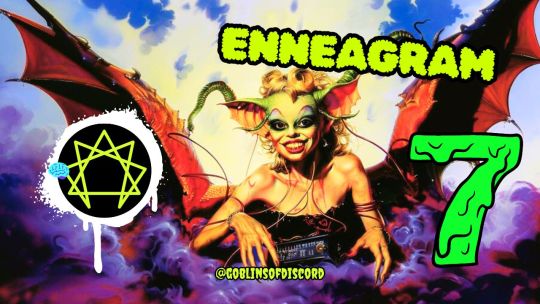
ENNEAGRAM TYPE 7 - “MAD HATTER HEDONIST”
7’s like to see themselves as interesting, exciting, innovative, individualistic, creative and fun. Therefore they cannot see themselves as boring, normal, part of the grind or a downer. Of course, when going too hard into the personality type’s false belief, it creates a big ol’ shadow.
7’s avoid feeling trapped, limited, stifled, cut off and bored. 7's unconsciously seek new, interesting people/things/situations/interests to reinforce their type's ego because it assures them that they are fascinating, buoyant, original and compelling creatures. Therefore their survival continues.
Because the 7 utilizes “gluttony” they are unlikely to allow themselves to stagnate for too long, moving onto the next thing and the next thing and the next thing.
How this manifests:
Rationalization: Which means the 7 can subconsciously (or consciously) rationalize away shitty behaviors and dodge responsibility. They are usually averse to their specific flavours of what is “painful” and will reframe reframe reframe themselves up up up and away from whatever that source of “pain” is. Whether it’s the guilt of doing something awful, or the fall-out of saying something flippantly, or the consequences of a thoughtless action. They’re especially prone to rationalizing if making the pain conscious means they’re not able to do, be or have something they desire.
Distraction: They go into distraction seeking mode via hedonism, intellectual stimulation, adventures, extreme sports, partying, being totally manic and creating for 3 days straight, shopping, etc when they want to avoid discomfort, pain, boredom.
Repression: They use repression to bury negative emotions (in whatever flavour they despise) and push away anything that makes them feel like they’ve been victimized. 7’s can be emotional and melodramatic but it’s in the flavour they find the most interesting. They’re not here to be a boring victim or cry themselves to sleep every night over a loser.
Anticipation/Planning: They can over idealize an outcome to the point where they are more about getting the dopamine hits off anticipation than actually doing the thing or seeing whatever their harebrained scheme is through to completion.
Entitlement: 7’s can be massive brats about getting what they want. As frustration types they’re often focused on what they don’t have and what they want, but because they’re assertive they’re more likely to chase after it, expect it to be given to them, or push people out of the way to get it.
Pleasure-seeking/Hedonism: 7’s reject that which is not pleasurable because there’s nothing in it for them. When 7’s get into this “thank you, next” pattern it can become impossible for them to actualize or stick to something long enough for them to enjoy the fruits of all their initial excitement. The sparkle fades and there’s nothing tasty for the 7 to stick around and lick, so they’re likely to start looking for something else.
Rebellion: Like 6’s, 7’s can also be rebellious, but their reasons for rebelling are likely centered around freedom (literally or freedom of expression), anti-censorship, pro-individuality/individual choice. They can also just rebel for the hell of it if they’re bored, or if there are hot people associated with a cause.
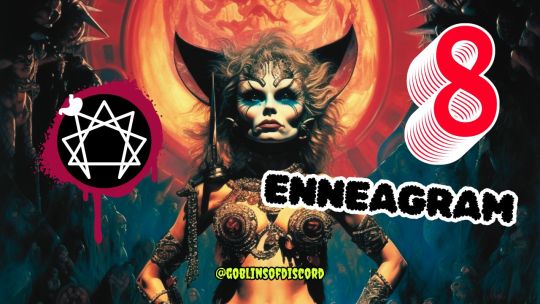
ENNEAGRAM TYPE 8 - “FINAL BOSS”
8’s like to see themselves as powerful, invulnerable, independent, intimidating IDGAF leaders. Therefore they cannot see themselves as weak, under someone else’s heel, being controlled, powerless or soft. Of course, when going too hard into the personality type’s false belief, it creates a big ol’ shadow.
8’s avoid feeling weak, vulnerable, powerless, small or allowing anything to threaten them. 8's unconsciously deny vulnerabilities and weaknesses to reinforce their type's ego because it assures them that they are indeed powerful and no one can or will fuck with them. Therefore their survival continues.
Because the 8 utilizes “lust” they are unlikely to allow themselves to put themselves in a position where they could be steamrolled, deprived, slowed down or made small or powerless.
How this manifests:
Denial: 8’s use “Denial” by rejecting their own vulnerabilities or weaknesses. This can show up as denying emotions, fears, thoughts that don’t serve the 8’s ego identification of being powerful. They can also completely deny the existence of any perceived weak points that an “enemy” could use against them. If possible, they will lop off anyone or anything that causes them agitation (people, situations) or seems like a threat to their inner or outer sanctuary that they’ve created.
Rejection/Coldness: They can view softness and receptivity as death. If they weaken for a moment, they’ll get screwed over or tricked.
Reaction Formation: 8’s can express the opposite of how they feel. So they can feel really hurt but act like they’re emotionally impervious. You have no effect on the 8. You don’t matter. If you’ve wounded their steel heart, you’ll pay the price. Like the 7 they can deny victimhood, but they might personally feel quite slighted and seek revenge to get the ball back in their court, the power back in their hands, for how the person made them feel.
Aggression/assertiveness: 8’s can take up space and project an air of confidence in order to pre-defend against would-be attacks. Showing up with big bear or chaos demon energy ensures no one will fuck with them and that they’ll get what they want. Therefore they can be domineering, bossy, straight-shooters. My way or the highway.
Control/conquering: 8’s can be hyper controlling and even paranoid, depending on their position and the situation. They can take on the role of puppetmaster or dictator, to ensure things happen according to their plan and they’re not at the whims of someone else or underneath someone else’s thumb.
Justification: 8’s can be impulsive with their anger and feeling absolutely justified. The desired effect can be to crush whatever is pissing them off with their brutality and force.
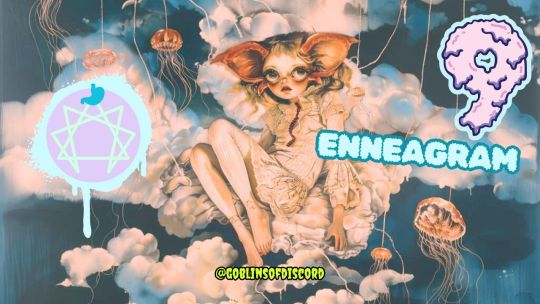
ENNEAGRAM TYPE 9 - “SOOTHING SQUISH”
9’s like to see themselves as chill, empathetic, caring, supportive and deep. Therefore they cannot see themselves as provocative, disruptive, thoughtless, aggressive or selfish. Of course, when going too hard into the personality type’s false belief, it creates a big ol’ shadow.
9’s avoid feeling in conflict and stressed out. 9's unconsciously seek to be in harmony and flow with those around them and their environment to reinforce their type's ego because it assures them that they are chill, harmonious and connected.
If the 9 catches themselves in the act, or someone else does (gasp), it may increase the dissonance between the Shadow and Unintegrated Self if they don’t understand that it’s just their personality bs. Because the 9 utilizes “sloth” they are unlikely to allow themselves to just get after it, make demands, make bold moves.
How this manifests:
Narcotization/Dissociation: 9’s use narcotization which means to numb, to ease discomfort. This can manifest in multiple ways, falling asleep at the wheel of life - outsourcing decisions, independence, physical needs, to others. It can also show up as losing yourself in mindless side-tasks instead of just dealing with problems. They can dissociate from problems by numbing their heart and mind to what’s in front of them, or to just hope it resolves itself without any involvement or disruption to the 9’s existence.
9’s repress their anger in favor of keeping peace. They can be really annoyed and not able to verbalize it until it reaches a crisis point for the 9. The other person may be totally shocked when it happens, especially if the 9 kept telling them that everything was fine.
Passive Aggression: 9’s express how they feel indirectly and hoping the person picks up on their subtle cues without them having to generate conflict. This can also just slip out subconsciously through offhand comments, looks, tone or behaviors. And when confronted with it, they’ll likely recede into a mist and say nothing’s wrong.
9’s can also use “positive reframing”, not unlike 7, but theirs is more used as a numbing agent, smoothing out a dire situation or other people’s malintent, rudeness, or shitty behavior so it doesn’t result in conflict or upset.
Outsourcing: 9’s often give their power away, instead of asking for what they want or expressing themselves without being prompted. They can become disappointed when others fail to mind-read or intuit their needs without them having to assert themselves or vocalize it.
Self-Forgetting: Because 9’s can dance around their location in order to keep the peace and not lose connection, they can forget what they want or how they really feel about something.
Merging: Like 3’s, 9’s merge with the people around them, often taking on their interests, aesthetics, values and even mannerisms. However the 9 isn’t doing it to become an ideal and compete for validation, they do it because they over-identify with the idealized other to create harmony and melt into them.
7’s and 9’s can both procrastinate and get lost in multiple fantasies of possibilities, but the difference is that the 7 is likely taking an active, assertive approach and throwing spaghetti at the wall, whereas the 9’s dreams can fade away if they don’t have another person holding them accountable or a job to show up for or something external.
Ghosting: Instead of just saying “no,” often 9’s will be vague or give a “maybe” or “sure” if they don’t know their location in the moment or don’t want to rock the boat. And then they’ll disappear when followed up with.
SELF-REFLECTION PROMPTS (FOR JOURNALING)
Did you cringe at any of the behaviors listed? did you recognize any of these in yourself?
write out which ones you recognized. no judgment. it's not "you", it's just behaviors Created out of your personality's false belief. Unpack them. go back to the situation. what were you feeling at the time? what was running through your mind?
What did you need to know in that moment to feel totally safe and make a different choice?
What different choice can you make next time?
What would be the worst thing someone could say about you or make you feel?
Is there anything in your life that you can see as you trying to avoid this being said about you, control people's perceptions, or avoiding feeling?
Can you accept this behavior in yourself right now, forgive yourself, and choose to be more consciously aware?
If you want the accompanying "Unf*ck Yourself" mini workshop + pdf workbook join the membership and get it instantly. I apologize for how dry this is. Want to get typed or coached by me? Book here.
#enneagram#enneagram types#enneagram 4#enneagram 7#enneagram 8#enneagram 3#enneagram 9#enneagram 6#enneagram 2#enneagram 1#enneagram 5#Youtube
111 notes
·
View notes
Text

A redraw of my INFP 6w5, in my own style.
6w5s live in the deepest parts of the Fi Forest, along with other xxFP 4's, 5's and 6's.
They are adept at camouflage, allowing them to blend easily into their surroundings to observe and analyze potential threats at a distance before deciding to strike.
Their colour schemes often reflect the dark, mysterious nature of their environment.
#mbti personality types#mbti types#mbti art#mbti#mbti infp#infp 6w5#infp art#enneagram#enneagram type 6#enneagram 6w5#mbti story#Fi Forest#Deep Forest xxFPs#enneagram art#illustration
65 notes
·
View notes
Text
halfway through catching fire (reading the hunger games for the first time) and all i can say is that katniss is soooooo enneagram 6. every thought that passes through that girl's head is about safety and/or fear
#i'd been thinking she was a 6 through most of hunger games 1#but then by the time i was like 3/4ths of the way through i was like WHY was i ever considering any other type for her she is SUCH a 6#now i'm trying to figure out gale's and peeta's. though katniss's pov is making that a bit difficult tbh sdlkjsdg#the hunger games#thg#elle rambles#enneagram#(current hypotheses are gale 4 & peeta 9. perhaps)#(if katniss would do anything else aside from kissing BOTH of them maybe i'd have an easier time knowing their personalities as Humans. smh
17 notes
·
View notes
Text









my sx-types: all enneagrams !!
idk why i forgot to post it there.
tg: lieadiam
#typology#enneagram#ennea#enneagram types#enneagram test#enneagram 1#enneagram 2#enneagram 3#enneagram 4#enneagram 5#enneagram 6#enneagram 7#enneagram 8#enneagram 9#sx1#sx2#sx3#sx4#sx5#sx6#sx7#sx8#sx9#gracaena#typing
54 notes
·
View notes
Text
ENNEAGRAM SIX INTRODUCTION (Doberman Pinscher)

Six perceives the world as too unpredictable. Their objective of life is to establish a sense of safety.
Their (unconscious) fear is loss of stability or certainty.
SEEKS:
SECURITY
By being prepared for potential problems or by relying on external guidance for decision-making.
COMPLIANT TO:
THEIR SAFETY NET
“I need to make sure of this.”
“Do I have something to fall back on?”
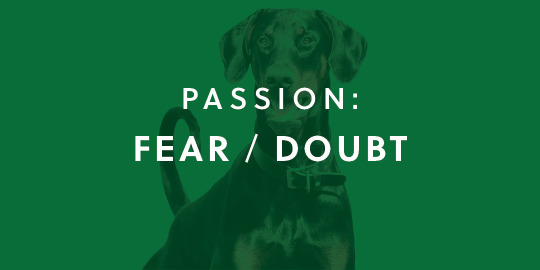
It’s an ongoing sense of anticipation about possible (physical, financial, emotional or social) problems. 6s keep a lookout for them but also experience chronic self-doubt in their own decisions or mistrust in the world that seems unstable and uncertain. Therefore, letting your guard down would be a dangerous move.
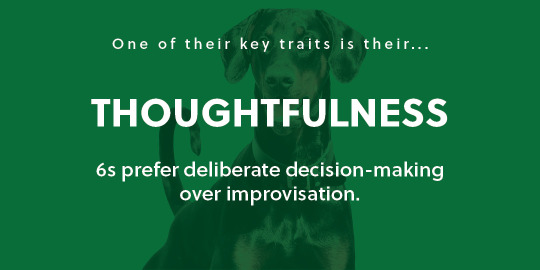
Healthy 6s channel their need for certainty and stability into practical preparedness. They are methodical and tackle problems or crises with courage and careful analysis, avoiding reckless actions. Their ability to stay on top of challenges help them protect themselves and others from trouble.
Average 6s anticipate potential problems at every turn and overthink or micromanage their environment to control their anxiety. This may result in risk aversion and indecision, driven by a fear of making harmful or irreversible choices. They become trapped in pessimism and might struggle with low self-esteem.
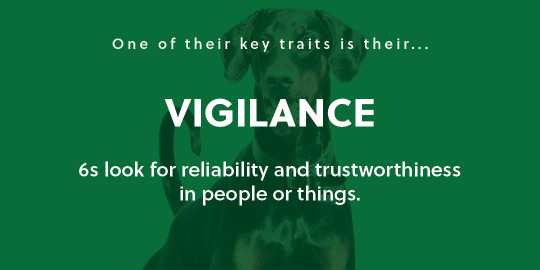
Healthy 6s display a balanced sense of critical thinking, allowing them to foresee problems. They can easily spot inaccuracies or unsafe situations and respond quickly to address them. They don’t feel the need to prove their strength nor their loyalty, instead trusting their own judgments to make the right decisions.
Average 6s lack confidence in their own abilities. They may become overly reliant on a person, job, community, rules or belief system to feel secure. Yet they struggle to determine who or what they can truly trust, increasing their doubt to the point they might even question their own mind in the process.
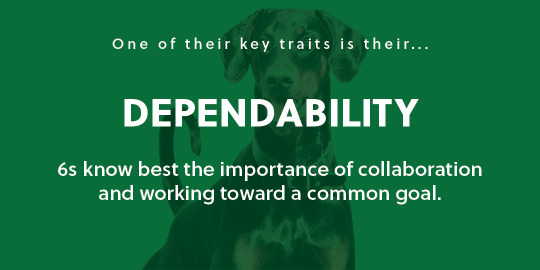
Healthy 6s feel mostly secure in their relationships and stand by their loved ones or communities through thick and thin and provide protection, stability and care for them. They are also excellent team members or coworkers, as they take their commitments, responsibilities, and work very seriously.
Average 6s are driven by a fear of being attacked, abandoned, or betrayed. They might be hyperalert to any changes in behavior and overreact if they perceive threats. Some 6s find people as too untrustworthy and avoid them altogether, while other 6s are overly dependent on people for reassurance.
-----
🔔 This is an introduction to the world of Enneagram. Stay tuned to my blog as I'm gonna explore each Enneagram type in depth in the coming weeks. 🔔
#enneagram#psychology#typology#personality#personality theory#spirituality#self growth#dog#personality types#enneagram 6#6w5#6w7#Doberman Pinscher
16 notes
·
View notes
Text
My Personality Info
Inspired by @sienablackwood
Sun Sign: Aries | Taurus | Gemini | Cancer | Leo | Virgo | Libra | Scorpio | Sagittarius | Capricorn | Aquarius | Pisces
Moon Sign: Aries | Taurus | Gemini | Cancer | Leo | Virgo | Libra | Scorpio | Sagittarius | Capricorn | Aquarius | Pisces
Rising Sign: Aries | Taurus | Gemini | Cancer | Leo | Virgo | Libra | Scorpio | Sagittarius | Capricorn | Aquarius | Pisces
Myers-Briggs: ESFP | ISFP | ESTP | ISTP | ESTJ | ISTJ | ESFJ | ISFJ | ENFJ | INFJ | ENFP | INFP | ENTP | INTP | ENTJ | INTJ
Life Path Number: 1 | 2 | 3 | 4 | 5 | 6 | 7 | 8 | 9 | 11 | 22 | 33
Four Temperaments: Sanguine | Melancholic | Choleric | Phlegmatic
Enneagram: The Reformer (Type 1) | The Helper (Type 2) | The Achiever (Type 3) | The Individualist (Type 4) | The Thinker (Type 5) | The Loyalist (Type 6) | The Enthusiast (Type 7) | The Leader (Type 8) | The Peacemaker (Type 9)
Instinctual variant: sp/so | sp/sx | so/sp | so/sx | sx/sp | sx/so
Tritype: 125, 152, 215, 251, 512, 521-The Mentor, 126, 162, 216, 261, 612, 621-The Supporter, 127, 172, 217, 271, 712, 721-The Teacher, 135, 153, 315, 351, 513, 531-The Technical Expert, 136, 163, 316, 361, 613, 631-The Taskmaster, 137, 173, 317, 371, 713, 731-The Systems Builder, 145, 154, 415, 451, 514, 541-The Researcher, 146, 164, 416, 461, 614, 641-The Philosopher, 147, 174, 417, 471, 714, 741-The Visionary, 258, 285, 528, 582, 825, 852-The Strategist, 259, 295, 529, 592, 925, 952-The Problem Solver, 268, 286, 628, 682, 826, 862-The Rescuer, 269, 296, 629, 692, 926, 962-The Good Samaritan, 278, 287, 728, 782, 827, 872-The Free Spirit, 279, 297, 729, 792, 927, 972-The Peacemaker, 358, 385, 538, 583, 835, 853-The Solution Master, 359, 395, 539, 593, 935, 953-The Thinker, 368, 386, 638, 683, 836, 863-The Justice Fighter, 369, 396, 639, 693, 936, 963-The Mediator, 378, 387, 738, 783, 837, 873-The Mover Shaker, 379, 397, 739, 793, 937, 973-The Ambassador, 458, 485, 548, 584, 845, 854-The Scholar, 459, 495, 549, 594, 945, 954-The Contemplative, 468, 486, 648, 684, 846, 864-The Truth Teller, 469, 496, 649, 694, 946, 964-The Seeker, 478, 487, 748, 784, 847, 874-The Messenger, 479, 497, 749, 794, 947, 974-The Gentle Spirit
Socionics: LII, LSI, ESI, EII, IEE, SEE, SLE, ILE, ESE, EIE, LIE, LSE, SLI, ILI, IEI, SEI
Big 5 (SLOAN): RCOAI, RCUAI, RLUAI, RCOEI, RLUEI, RCOAN, RLUAN, RCOEN, RLUEN, RLOAN, RCUAN, RLOEN, RCUEN, RLOAI, RLOEI, RCUEI, SCOAI, SCOAN, SLOAN, SLOAI, SLUAI, SLUAN, SCUAN, SCUAI, SCOEI, SCOEN, SLOEN, SLOEI, SLUEI, SLUEN, SCUEN, SCUEI
Attitudinal Psyche: FVLE, LVFE, VLFE, VFEL, VLEF, LVEF, FLVE, LFVE, VFLE, VEFL, VELF, LEVF, EVLF, EVFL, ELFV, LFEV, FLEV, FVEL, ELVF, EFVL, EFLV, LEFV, FELV, FEVL
Classic Jungian: IN(T), IT(S), ET(N), ES(F), IN(F), IT(N), ET(S), ES(T), IS(T), IF(N), EF(S), EN(F), IS(F), IF(S), EF(N), EN(T)
Celtic Zodiac: Birch (The Achiever) | Rowan (The Thinker) | Ash (The Enchanter) | Alder (The Trailblazer) | Willow (The Observer) | Hawthrone (The Illusionist) | Oak (The Stabilizer) | Holly (The Ruler) | Hazel (The Knower) | Vine (The Equalizer) | Ivy (The Survivor) | Reed (The Inquisitor) | Elder (The Seeker)
Celtic Animal Sign: Stag/Deer | Cat | Cow/Bull | Horse | Butterfly | Adder/Snake | Seahorse | Fish/Salmon | Wolf/Hound | Fox | Wren | Swan | Falcon/Hawk
Soul Type (one test): Hunter | Caregiver | Creator | Thinker | Helper | Educator | Performer | Leader | Spiritualist
Hogwarts House: Gryffindor | Hufflepuff | Ravenclaw | Slytherin | Gryffinpuff/Huffledor | Gryffinclaw/Ravendor | Ravenpuff | Slytherclaw | Slytherdor | Slytherpuff
The Animal in You: Lion | Tiger | Dolphin| Bear | Wild Cat | Fox | Weasel | Badger | Dog | Otter | Wolf | Sea Lion | Wild Dog | Walrus | Gorilla | Deer | Rhinoceros | Hippo | Sable | Horse | Sheep | Mountain Goat | Warthog | Zebra | Baboon | Elephant | Bison | Giraffe | Cottontail | Mole | Bat | Porcupine | Beaver | Prairie Dog | Shrew | Mouse | Eagle | Rooster | Owl | Swan | Peacock | Vulture | Penguin | Crocodile | Snake
Brain Lateralisation Test: Left | Right
Cerebral Personality Test: 1-10% | 11-20% | 21-30% | 31-40% | 41-50% | 51-60% | 61-70% | 71-80% | 81-90% | 91-100%
Multiple Intelligences Test: Kinaesthetic | Linguistic | Logical | Interpersonal | Intrapersonal | Musical | Visual/Spatial | Naturalistic
Levenson Self-Report Psychopathy Scale (Primary Psychopathy): 1 | 1.5 | 2 | 2.5 | 3 | 3.5 | 4 | 4.5 | 5
Levenson Self-Report Psychopathy Scale (Secondary Psychopathy): 1 | 1.5 | 2 | 2.5 | 3 | 3.5 | 4 | 4.5 | 5
DISC Profile: D | I | S | C
VIA Character Traits: appreciation of beauty, bravery, curiosity, creativity, forgiveness, fairness, gratitude, honesty, humor, hope, humility, kindness, leadership, love, love of learning, judgment, forgiveness, perseverance, perspective, prudence, teamwork, social intelligence, spirituality, self-regulation, zest
Alignment: Lawful Good | Neutral Good | Chaotic Good | Lawful Neutral | True Neutral | Chaotic Neutral | Lawful Evil | Neutral Evil | Chaotic Evil
Aura Color: Red | Orange | Magenta | Yellow | Logical Tan | Environmental Tan | Sensitive Tan | Abstract Tan | Green | Blue | Violet | Crystal | Lavender | Indigo
[7] Soul Types: Server | Artisan | Warrior | Scholar | Sage | Priest | King
Deadly Sin: Wrath | Envy | Gluttony | Greed | Sloth | Lust | Pride
Nerdy Personality Attribute Scale: 30 | 40 | 50 | 60 | 70
Helen Fisher’s Personality Test: Explorer | Builder | Director | Negotiator
MOTIV: Materialistic | Ascetic | Offbeat | Conventional | Thinking | Haphazard | Interpersonal | Withholding | Vital | Depressed | Easygoing | Rigid
Holland Code: Realistic | Investigative | Artistic | Social | Enterprising | Conventional
Defense Mechanism: Regression | Displacement | Denial | Repression | Intellectualization | Reaction Formation | Projection | Compensation
R-Drive Personality Test: Narcissism | Unconventionality | Empiricism | Vitality | Othercentricism | Independence | Integrity | Intellect | Stoicism | Orderliness | Dynamism | Activity | Romanticism | Hedonism
#personality tests#mbti types#mbti#enneagram#infj#deadly sins#soul types#aura colors#lavender aura#pdbee#personality database#enneagram 6#so/sx
29 notes
·
View notes
Text
The Enneagram of Divine Forms — Point 6: The Adventurer
Total lack of faith in themselves, in other human beings, and in God
Thinks they are completely lost and alone in the world
For them it is hard to believe in the goodness of humanity, and also in their own goodness
Profoundly distrustful of God, humankind and even the world, and in a very deep sense, distrustful of the goodness of their own ability
Constant superstition and neurotic paranoia of being persecuted, misled, lied to, and even more
General attitudes of fear and stress, which gives them the outward appearance of being a ‘nervous wreck’
Because of this constant distrust, suspicion and fear, every single event or situation becomes an adventure of major proportions
Ego-delusion: that they are engaging in dangerous and fearful situations in which they are being used and exploited; because they have no faith in themselves, they have a cowardly attitude, think that their ongoing fear and stress become manifested by their suspiciousness and by their hostile outbursts and constant shortcomings, always being insecure and not knowing if they are choosing the best and the right path or situation; cowardice, they see everything across with exaggerated fear
Cynical point of view that everybody is actually moved only by self-interest and self-gratification
Internally very weak without any faith in themselves
Extremely inconsequential, inconsistent and capable of changing positions and points of view without warning
Applying their specific cynicism to their lack of consistency and consequence
Projection of believing they are useless in relation to their siblings or the world, which provokes tension in them
Passion of fear: passionately promote an internal state of fear by being distrustful and by believing they are in constant imminent danger
Striving and pushing on one side, lazy and indifferent on the other
Projection: their primary defense mechanism, by which unacceptable thinking, fears or behavior are rejected in themselves and projected onto another person, group, race or religion, without insight and acknowledgement of their own internal process
Self-defeating attitude
Assert to themselves: ‘I am responsible and relaxed’
Ego-reaction: become a libertine and an outgoing type of person to combat and hide their fear
Ego-justification: calculation, to accommodate their arguments for their own benefit
Uses panic in order to escape from situations that they cannot control
Agreeable on one side and overpowering on the other
Source: @/if u seek amy on PDB
#personality theory#personality types#typology#enneagram#ichazo#enneagram 6#6w5#6w7#entj#estj#infj#infp#intj#intp#istj#istp
76 notes
·
View notes